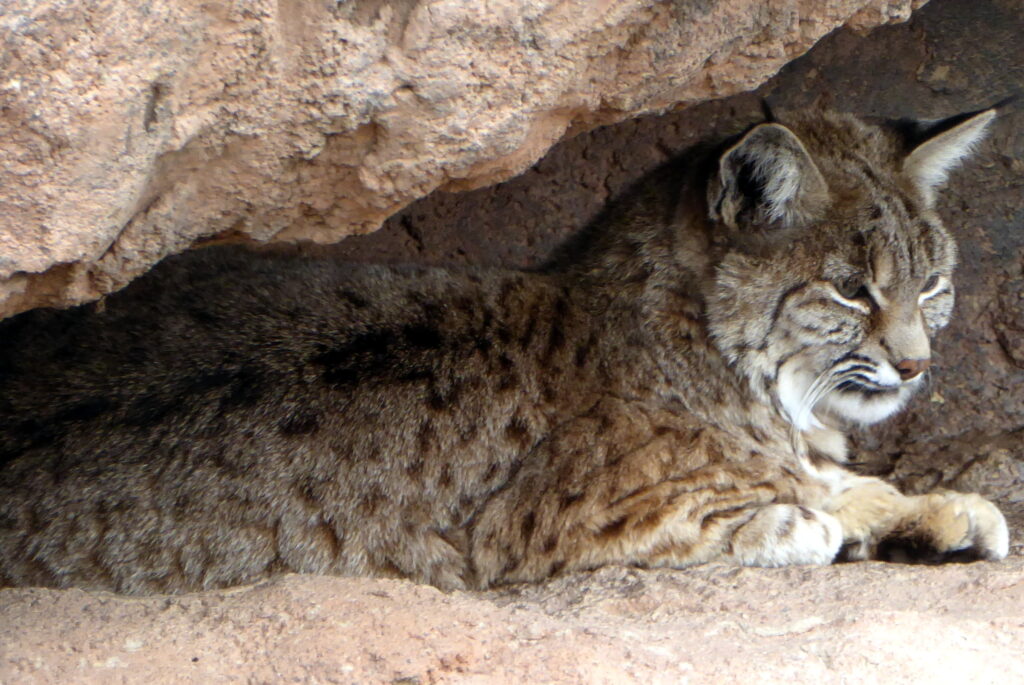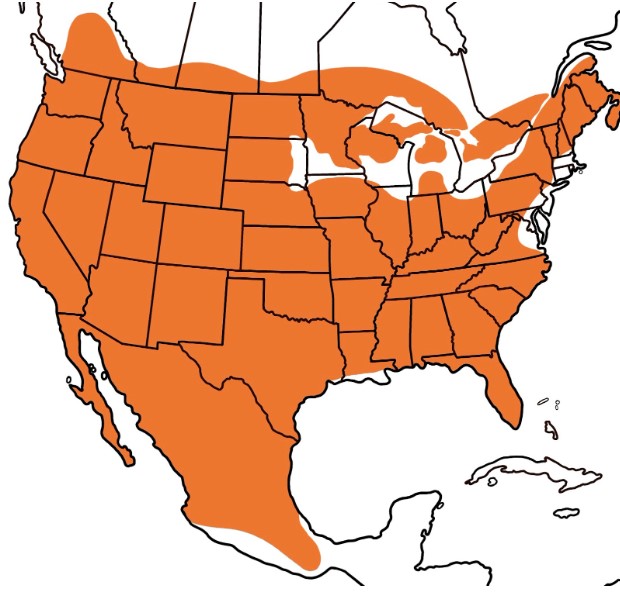Bobcat, Lynx rufus
 Bobcat, Lynx rufus. Cat photographed within the confines of the Arizona-Sonora Desert Museum, Tucson, Arizona, February, 2022.
Bobcat, Lynx rufus. Cat photographed within the confines of the Arizona-Sonora Desert Museum, Tucson, Arizona, February, 2022.
The Bobcat, Lynx rufus, is a member of the Felidae family of Cats. The Felidae family has thirty-six species in eighteen genera. There are four species in the Lynx genus. Currently, there are twelve recognized subspecies of Bobcat that vary in coloration and size according to their geographic range. The Bobcat is also known at the Red Lynx and in Mexico as Gato Montés.
Bobcats are a medium-sized cat and are named after their short, bobbed tail which only grows to 15 cm (5.9 inches)in length. Their fur is buff to brown, sometimes with a reddish tinge, and marked with spots or lines of black or dark brown. The intensity of these markings depends on the individual and where they live. Those found in more open, arid areas tend to have fewer markings than those found amongst dense cover. The fur on their underside is lighter in color and their short tail is black with a white underside. They have facial ruffs, ear tufts, and white spots near the tips of their ears. Bobcats vary in size along their continental range, with larger Bobcats found in the north and smaller Bobcats found in the south. They are generally 46 cm (1 foot 6 inches) to 64 cm (2 feet 1 inch) tall at the shoulder and weigh between 4 kg (9 lbs) and 15 kg (33 lbs).
Bobcats have a polygynandrous mating system with both males and females having multiple partners. Their mating season is primarily in the winter, although mating can occur from November through August. Outside of mating season, Bobcats are solitary and do not associate with one another. Female Bobcats are spontaneous ovulators, meaning their ovulation occurs spontaneously due to environmental factors such as sunlight. During mating season, females leave scent markings, such as urine, for males to follow. Yowls, screeching, and other vocalizations are more common during this time as they search for mates. Fights between males are not uncommon and can be loud and ferocious. When a male approaches a female, he is either clearly welcomed or aggressively fought off by the female depending on her state of receptivity. If receptive, the female will become highly vocal, arch her back, and circle the male. The two then engage in play behavior, throwing themselves at one another and chasing. Copulation can occur up to 16 times a day for several consecutive days. Gestation is about 60 to 70 days and there are typically 2 to 4 kittens per litter. Bobcats den in places protected by the weather, such as hollow trees, caves, under dense shrubs, and between boulders. The female lines the den with moss and foliage, and the kittens are typically born in the spring. Kittens are about 20.3 cm (8.0 inches) in length and weigh between 226.8 g (8 oz) to 368.5 g (13 oz) at birth. Once the kittens are born, the female drives away the male, however the male will stay in the area. Kittens open their eyes at ten days old and the female nurses them for two months. Females bring meat to their kittens, and, once weaned, teaches them how to hunt. The kittens travel with the female for three to five months before they separate for the winter mating season. If the kittens fall too far behind their mother, the mother stops and softly calls to them while raising her tail to reveal its white underside, providing a visual signal for the kittens to follow. Females become sexually mature and mate after one yea; males do not mate until they are two years old. Bobcats have life spans of five to fifteen years in the wild and eighteen years in captivity.
Bobcats are highly territorial and mark their specific territories to minimize confrontations with other Bobcats. They mark with scent by urinating along travel routes, depositing feces in latrine sites, and scraping urine and feces along trails. These markings can indicate that a specific den is being used by a female and her kittens, signal that a female is receptive to mating, or delineate a home range. In addition, they use body postures and facial expressions as close-range signals to ward off intruders. They rarely use sound to deter other Bobcats and instead rely on urine, feces, anal gland secretions, and visual signals.
Bobcats may be active during all hours of the day and night, but studies have consistently found that they are crepuscular (most active during dawn and dusk). They are excellent climbers and can run up to 48 km per hour (30 mph). They stalk their prey with patience are known to travel from 3 km (2 miles) and 11 km (7 miles) in an evening while hunting and patrolling their territory. To reduce noise when hunting, they will place their back feet in the same spots where their front feet have stepped. Bobcats primarily eat rabbits and hares, but they also consume rodents, small deer, snakes, lizards, and domestic animals such as cats, dogs, sheep, goats, and poultry. They can even leap high enough to catch low-flying birds.

From a conservation perspective the Bobcat is currently considered to be of Least Concern with abundant, wide-ranging population. They face several ongoing threats including habitat loss and genetic isolation due to increasing urbanization and the constriction of roads. In addition, canine distemper and canine distemper-associated encephalitis have been documented in Bobcats found in eastern Canada. Bobcats are generally shy and elusive and are not known to attack humans when they are healthy. In the unlikely event that a Bobcat is encountered, EXTREME CAUTION should be used. Do not run and keep facing the Bobcat while backing away slowly. Make a lot of noise and if available, throw water at the Bobcat to scare it off. It is important to never run away from a Bobcat, as that can trigger a prey response and an attack.